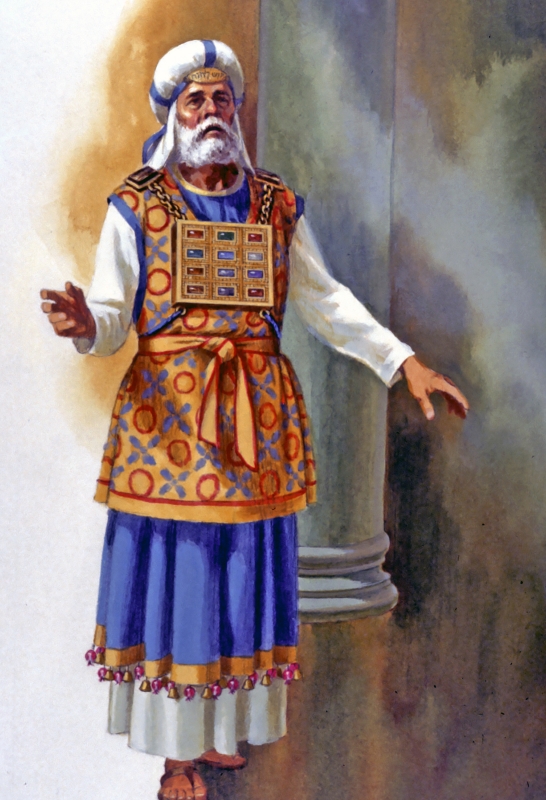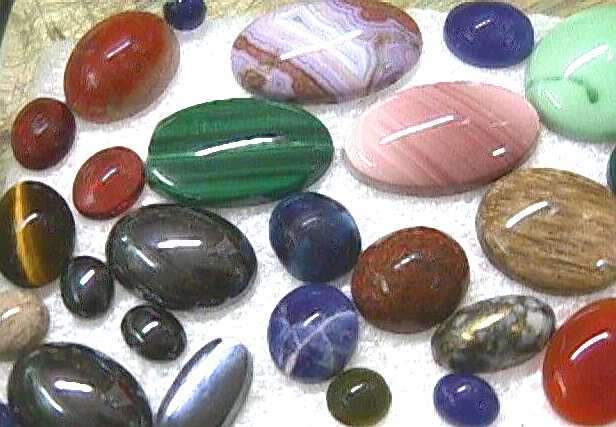The Priestly Garments of Grace
By Stephen Terry
 “Fashion a breastpiece
for making decisions—the work of skilled hands. Make it like the ephod: of
gold, and of blue, purple and scarlet yarn, and of finely twisted linen. It is
to be square—a span long and a span wide—and folded double. Then mount four rows
of precious stones on it. The first row shall be carnelian, chrysolite
and beryl; the second row shall be turquoise, lapis lazuli and emerald; the
third row shall be jacinth, agate and amethyst; the fourth row shall be topaz,
onyx and jasper. Mount them in gold filigree settings. There are to be twelve
stones, one for each of the names of the sons of
“Fashion a breastpiece
for making decisions—the work of skilled hands. Make it like the ephod: of
gold, and of blue, purple and scarlet yarn, and of finely twisted linen. It is
to be square—a span long and a span wide—and folded double. Then mount four rows
of precious stones on it. The first row shall be carnelian, chrysolite
and beryl; the second row shall be turquoise, lapis lazuli and emerald; the
third row shall be jacinth, agate and amethyst; the fourth row shall be topaz,
onyx and jasper. Mount them in gold filigree settings. There are to be twelve
stones, one for each of the names of the sons of
The high priest of the sanctuary was a
symbolic representation of Christ's intercessory role. The symbolism
extended to the breastplate he wore. Christians have mixed reactions to
wearing gems and jewelry. Some feel it is a gateway to evil, while others
feel they cannot get enough of them. However, God has no such reservations
about gems. To Him, they are but tools to a greater purpose, the
revelation of His grace.
The high priest continually ministered
in the sanctuary in a symbolic service that represented the removal of the sin
barrier that prevented a relationship between God and man. The priest
performed this service continually because it could never effectively repair
that relationship. Only the more perfect ministry of Jesus in heaven could
accomplish that. The high priest's round of ministry culminated each twelve
months in the service of the Day of Atonement when he would enter the holiest
part of the sanctuary to perform a cleansing ritual. The number twelve in
the Bible is often used to represent fulfillment, completion or perfection.
 This number twelve was also reflected on
the high priest's breastplate. The twelve gemstones represented the
perfection of God's love for His people. In that symbol of perfect love,
the priest also represented Jesus. As each stone was engraved with the name of
one of Jacob's sons, the symbolism of holding each of us by name close to
Jesus' heart is a comforting one. Even choosing jewels to symbolize this
is a testament to the value He places on each of us. We sometimes build
magnificent cathedrals to honor God, but God chose these beautiful gems to
honor us.
This number twelve was also reflected on
the high priest's breastplate. The twelve gemstones represented the
perfection of God's love for His people. In that symbol of perfect love,
the priest also represented Jesus. As each stone was engraved with the name of
one of Jacob's sons, the symbolism of holding each of us by name close to
Jesus' heart is a comforting one. Even choosing jewels to symbolize this
is a testament to the value He places on each of us. We sometimes build
magnificent cathedrals to honor God, but God chose these beautiful gems to
honor us.
While the exact name of the gems has
been lost to antiquity, the Bible account makes it clear that each gem was
chosen individually for its place in the breastplate. God also specified
which name was to be engraved in each stone, for He instructed that the names
would be engraved in the order of the birth of Jacob's sons. Perhaps if we knew
the exact gems that were chosen we could find more meaning in this. But
the number twelve still allows us to ferret out some additional information.
We see the number recurring throughout the Bible, and this gives us some
clues.
There were twelve patriarchs from Seth
to Noah and twelve from Shem to Jacob. In the Old Testament, altars were
usually constructed of 12 uncut stones. Also, there were the twelve apostles of
Jesus. The
There is also another list of gems in
the Bible. That list is associated with Lucifer. However, that list
includes only nine gems. This signifies a limitation in his authority as
compared to Christ. After all, he was a created angelic being, while
Christ had life underived. While Lucifer received life from God, Jesus is
life.
The number nine associated with
Lucifer's gems is a popular number with practitioners of the occult. You can
see the reasons why with a little mathematics. 2 x 9 = 18 ( 1 + 8 = 9), 3 X 9 = 27 (2 + 7 = 9), 4 X 9 = 36 (3 + 6 = 9)
, and so on. When the numbers get too large to add up to only nine, then
the sum of the numbers still adds up to a multiple of nine then those numbers
add up to nine. For example 52843 x 9 = 475587 (and
4+7+5+5+8+7=36, and 3+6=9). It is easy to see why some believe that
the number has special properties. However, nine is also the last of the single
digits so it also represents an end. In this sense it may represent the end of
sin and consequently the end of Lucifer in judgment. Even the number 666 which
we all know from Revelation 13 is associated with the devil is a multiple of
nine (9 x 74).
More can be said about this comparison.
Where God holds the twelve gems close to his heart, Lucifer uses them for his
personal adornment and the pride he took in his beauty led him to sin. Where
Christ seeks the restoration of the relationship between God and His people,
Lucifer sought to exalt himself and undermine the relationship between God and
the angels in heaven. Having been cast from heaven, he continues to make every
effort to destroy the relationship between God and man on earth as well. This
may be the root of the fear that some Christians hold for gems. However, the
Bible makes clear it is what is in the heart and not the gemstones that make the
difference.
Returning to the symbolism of the high
priest, we see that his annual cycle also is involved with the number twelve as
every twelfth month, he completed the cycle of grace with the Day of Atonement.
Perhaps this is another aspect of Jesus' statement that He was the fulfillment
of the law. The priest's annual cycle could never truly fulfill or complete the
cycle of grace. If it could why would it need to be continually repeated? But
Jesus' ministry in heaven was a completion, a fulfillment of grace. It does not
need to be repeated.
"For Christ did not enter a
sanctuary made with human hands that was only a copy
of the true one; he entered heaven itself, now to appear for us in God’s
presence. Nor did he enter heaven to offer himself again and again, the way the
high priest enters the Most Holy Place every year with blood that is not his
own. Otherwise Christ would have had to suffer many times since the creation of
the world. But he has appeared once for all at the culmination of the ages to do
away with sin by the sacrifice of himself. Just as
people are destined to die once, and after that to face judgment, so Christ was
sacrificed once to take away the sins of many; and he will appear a second
time, not to bear sin, but to bring salvation to those who are waiting for
him." Hebrews 9:24-28, NIV
Once Jesus gave Himself on the cross to
reconcile us to God, there was no need for the symbolism of the continual
service of the high priest on earth. This is why Matthew 27:51 tells us
that when Jesus died on the cross "At that moment the curtain of the temple was
torn in two from top to bottom." NIV This was the curtain that
separated the holy part of the sanctuary from the holiest part. The curtain hid
the holiest area from view and only the high priest could enter there once a
year for the Day of Atonement. With Jesus' death, the symbolism was no longer
necessary. Now all could come directly to God for cleansing because of the
reconciliation He brought about.
I find it comforting to know that God
used the symbolism of precious gems held close to His heart to represent us.
This gives me peace as I approach God through Jesus to seek cleansing from my
sins and reconciliation with such a loving God. One day, I want to walk with
Jesus, our true High Priest, and thank Him personally for all He has done for
us. Wouldn't you like to walk with him, too?
![]()
If you
do not have the current Bible
Study Quarterly, you may purchase one by clicking here and typing the word
"quarterly" into the search box.